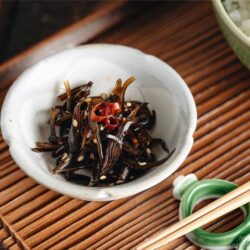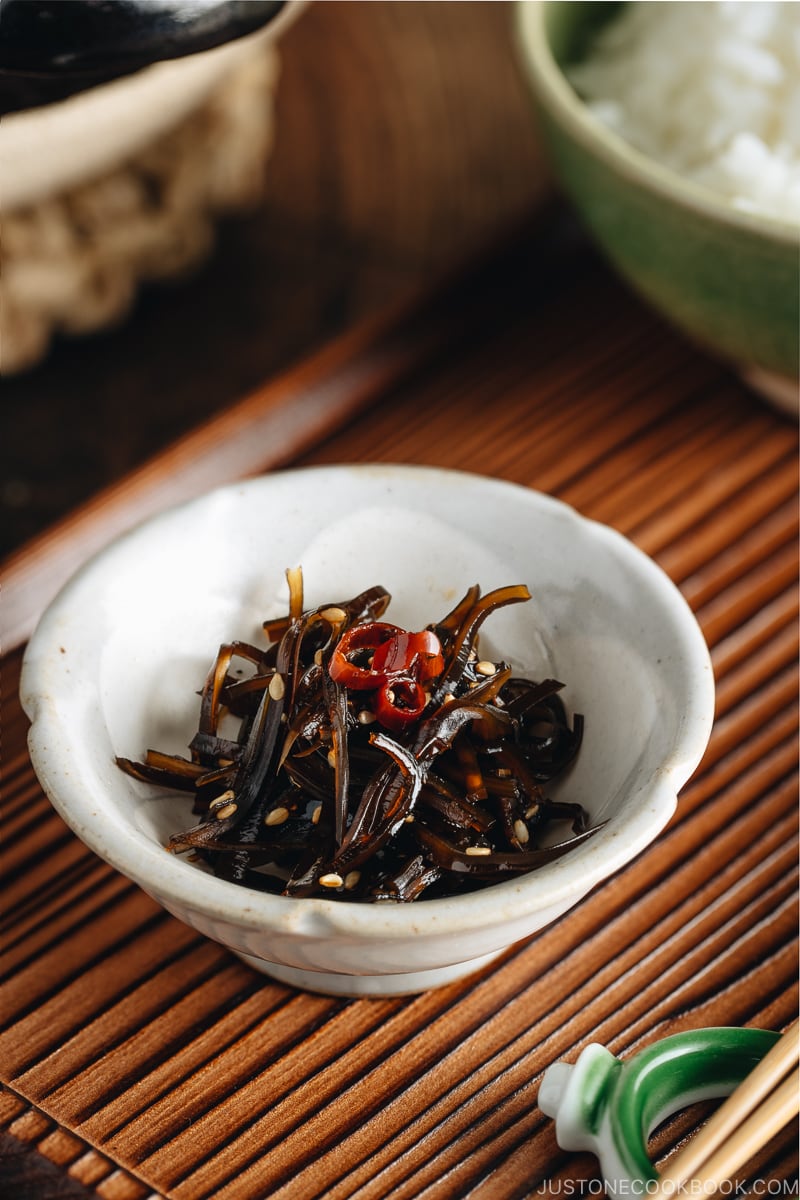
Once you start making Japanese dishes, you will realize you are left with a lot of used kombu from making homemade dashi (Japanese soup stock), mentsuyu (noodle soup base), or ponzu sauce. You may wonder what to do with the spent kombu.
Don’t throw those leftover kombu pieces away! You can repurpose them into a delicious simmered kombu dish called Kombu Tsukudani. Follow my recipe and tips below to make this easy and tasty side dish.
What is Tsukudani?
Tsukudani (佃煮) is a preparation where an ingredient is simmered for a long time in a sweet and savory sauce (typically made from soy sauce, sugar, and mirin). It usually has an intensely sweet and savory flavor, which helps preserve the ingredients.
Because of the strong flavor, tsukudani has been served as a side dish to accompany plain steamed rice since the Edo period (1600s–1800s). We call it gohan no okazu (ご飯のおかず), or rice side dish, as it’s eaten with steamed rice as a flavoring agent.
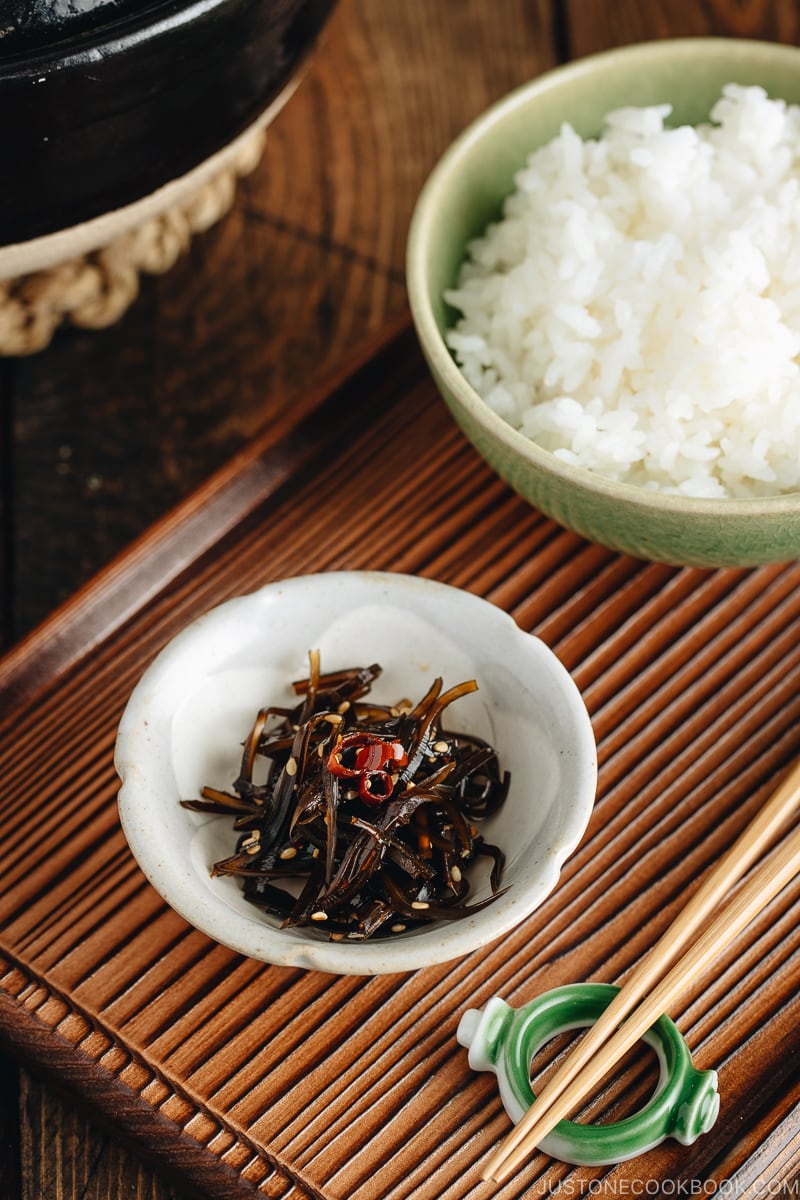
What is Kombu Tsukudani?
Kombu tsukudani (昆布の佃煮) is one of the most common types and it’s an excellent way to use up all your spent kombu. Other typical ingredients to make into tsukudani are seafood/fish (like baby sardines), shellfish, meat, seaweed, and vegetables.
Kombu tsukudani keeps for up to 2 weeks in the fridge, so it’s a great dish to make ahead and keep on hand. Tsukudani is always served and eaten chilled from the refrigerator and is not cooked again prior to eating.
Why You’ll Love This Recipe
- Repurpose spent kombu – Save those leftover kombu pieces in the freezer until you have time or enough kombu to make this dish.
- Great meal prep dish – It’s one of Japan’s delicious plant-based dishes that you can add to your meal prep recipe collection.
- Flavor booster for your bowl of rice or rice ball – Tsukudani adds a wonderful savory boost to your steamed rice or onigiri. For a spicy kick, try adding chopped dried red chili pepper!
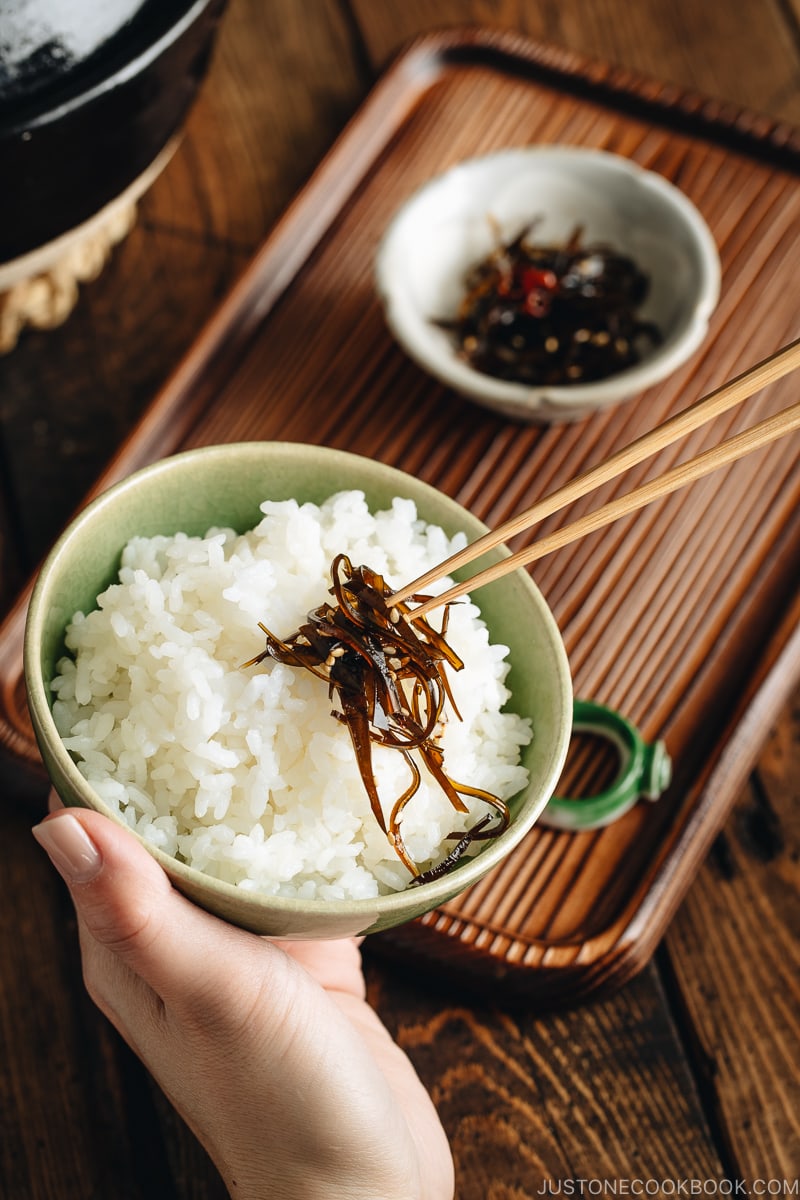
Ingredients for Kombu Tsukudani
- spent kombu (kelp) – leftover from another use; I used hidaka kombu that‘s tender and easy to cook
- toasted sesame seeds
- dried red chili pepper (赤唐辛子) – If you like it spicy, you can add two pieces, but one is good for our family
- water
- mirin
- sake
- rice vinegar (unseasoned)
- soy sauce
- sugar – you can add more for a sweeter taste
- katsuobushi (dried bonito flakes) – optional; skip for vegan/vegetarian
The Best Kombu for Tsukudani
For the best texture, hidaka kombu (日高昆布) is the most suitable choice for tsukudani. It gets tender a lot faster than other types. Ma kombu and rishiri kombu are thick and hard to cook.
Do you know which type of kombu are you using? If not, check out my kombu post where I discuss the different types.
If you use different types of kombu in your cooking like I do, I recommend freezing the spent kombu separately based on variety. Then you can cook it according to kombu type for a consistent result.
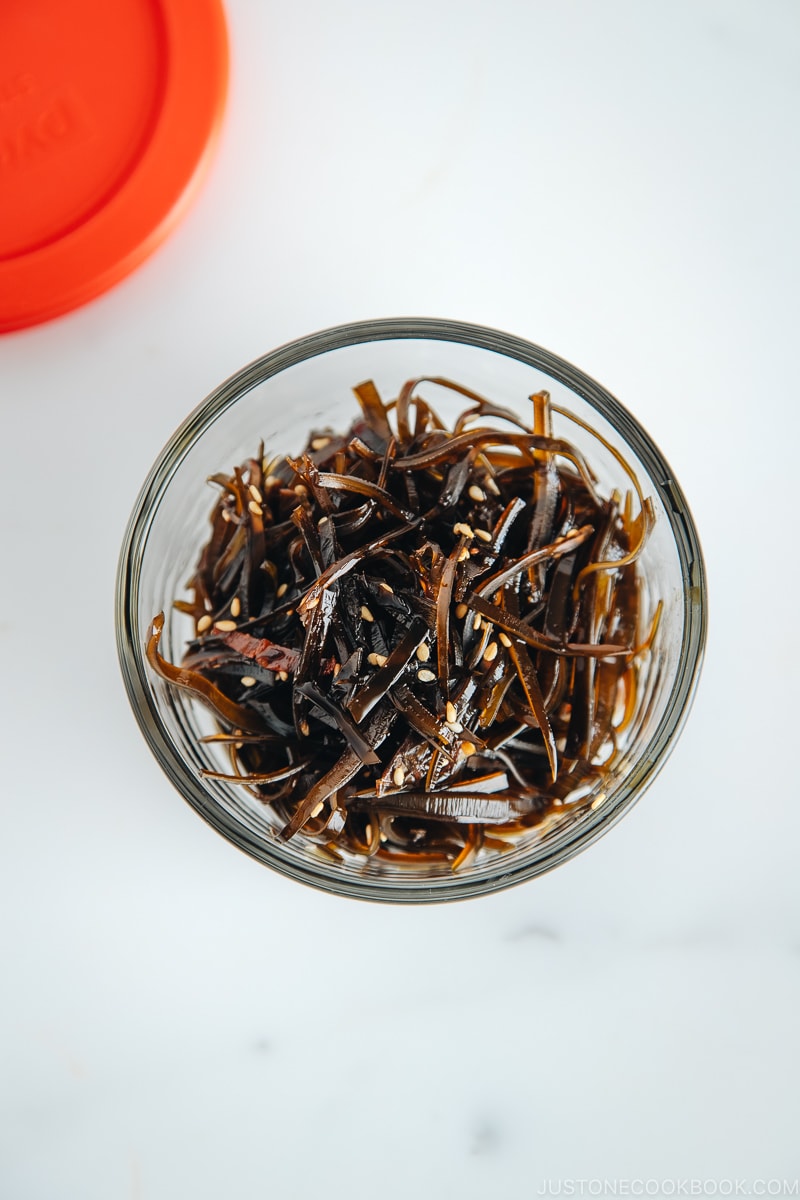
How To Make Kombu Tsukudani
- Cut the kombu into thin strips.
- Cut the chili pepper into thin rounds.
- Simmer the kombu strips in a medium saucepan with the water, sake, and mirin. Then, add the rice vinegar, Japanese soy sauce, sugar, and optional katsuobushi. Add the red chili pepper.
- Bring the liquid to a boil over medium heat, then reduce the heat to low.
- Simmer until most of the liquid evaporates, about 20–25 minutes. If the kombu is still not tender, add water and continue to cook. Taste and adjust the seasoning to your liking.
- Sprinkle with sesame seeds.
You can store the leftovers in a jar or other airtight container in the fridge for up to 2 weeks. Serve it chilled.
3 Tips for Tender Kombu Tsukudani
Here are my tips for making delicious, tender kombu tsukudani:
1. Choose the right type of kombu.
If you plan to make kombu tsukudani, pick a tender variety of kombu like hidaka kombu. But sometimes you just have to use whatever kombu you have. In that case, try my next tip #2.
2. Add rice vinegar while simmering.
In Japan, kombu is often cooked with a little bit of rice vinegar, which tenderizes the kombu. Don’t add too much though. You don’t want the tsukudani to taste vinegary.
3. Refill the water and cook until tender.
If the kombu hasn’t turned tender after simmering for 20–25 minutes, add some water and continue to simmer until it gets to the right texture.
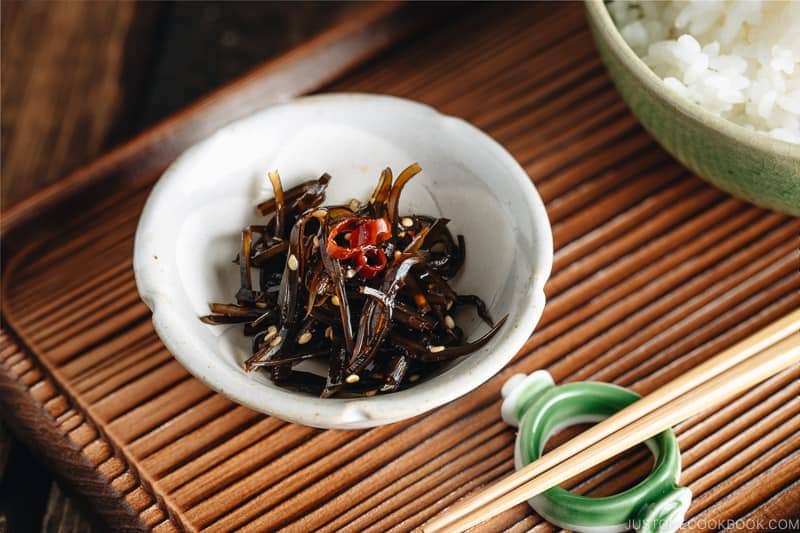
Wish to learn more about Japanese cooking? Sign up for our free newsletter to receive cooking tips & recipe updates! And stay in touch with me on Facebook, Pinterest, YouTube, and Instagram.
Kombu Tsukudani (Simmered Kombu)
Ingredients
- 2 oz used kombu (kelp) (you can use up to 4 oz (113 g); I used spent Hidaka kombu that‘s tender and easy to cook; Ma kombu and Rishiri kombu are thick and hard to cook; read about the different types of kombu)
- ½ tsp sesame seeds
For the Seasonings
- 1 dried red chili pepper
- 1 cup water
- 1 Tbsp mirin
- 1 Tbsp sake
- 1 tsp rice vinegar (unseasoned)
- 2 Tbsp soy sauce (or more, if needed)
- 2 tsp sugar (or add more for a sweeter taste)
- ½ tsp katsuobushi (dried bonito flakes) (optional; skip for vegan/vegetarian)
Instructions
- Gather all the ingredients.
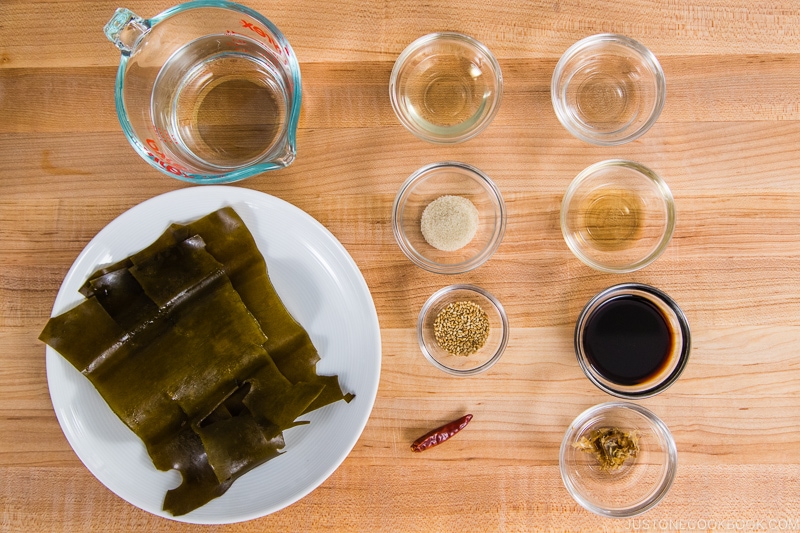
- Cut 2 oz used kombu (kelp) into thin strips.
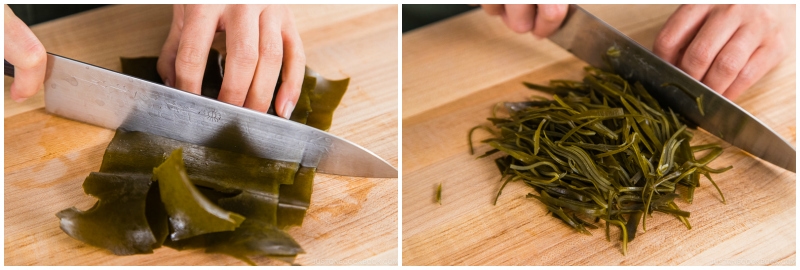
- Remove the seeds from 1 dried red chili pepper and cut it into thin rounds.
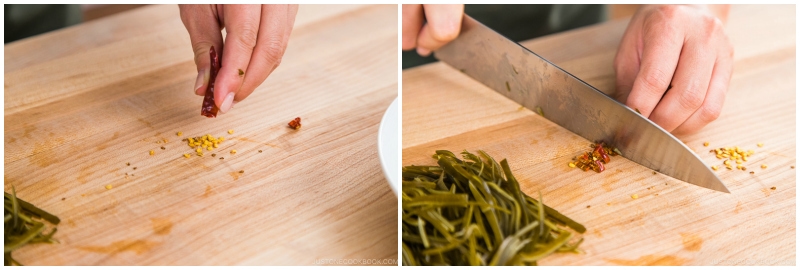
- Transfer the sliced kombu to a medium saucepan. Add 1 cup water, 1 Tbsp sake, and 1 Tbsp mirin.
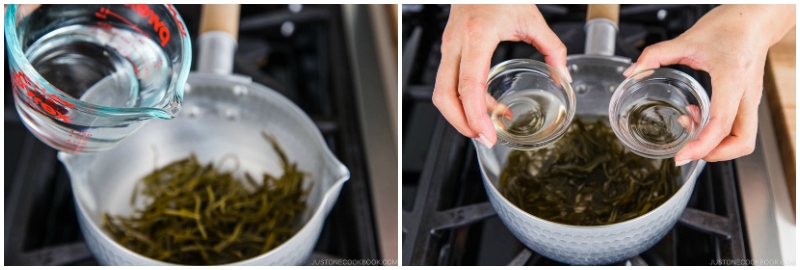
- Add 1 tsp rice vinegar (unseasoned), 2 Tbsp soy sauce, 2 tsp sugar, and ½ tsp katsuobushi (dried bonito flakes).

- Add the red chili pepper. Bring the liquid to a boil over medium heat.
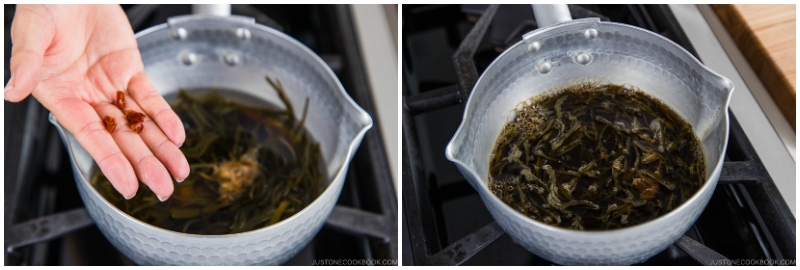
- Once boiling, reduce the heat to low and simmer until the liquid is almost evaporated, about 20–25 minutes. If the kombu is still not tender, add water and continue to cook. Check the taste and add more sugar and/or soy sauce, to your liking.
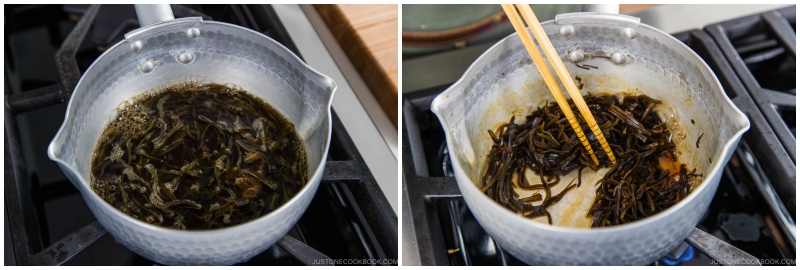
- Sprinkle ½ tsp sesame seeds on top. It‘s ready to serve.
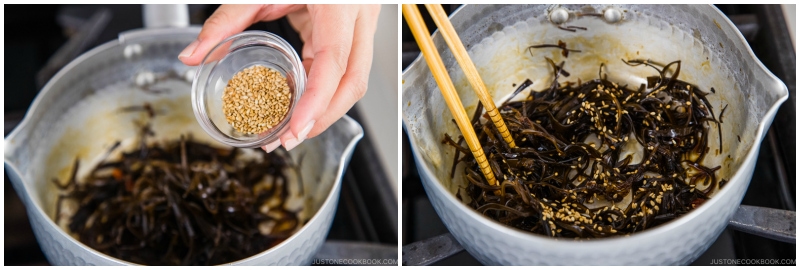
To Store
- Keep the Tsukudani in the refrigerator and consume within 2 weeks.
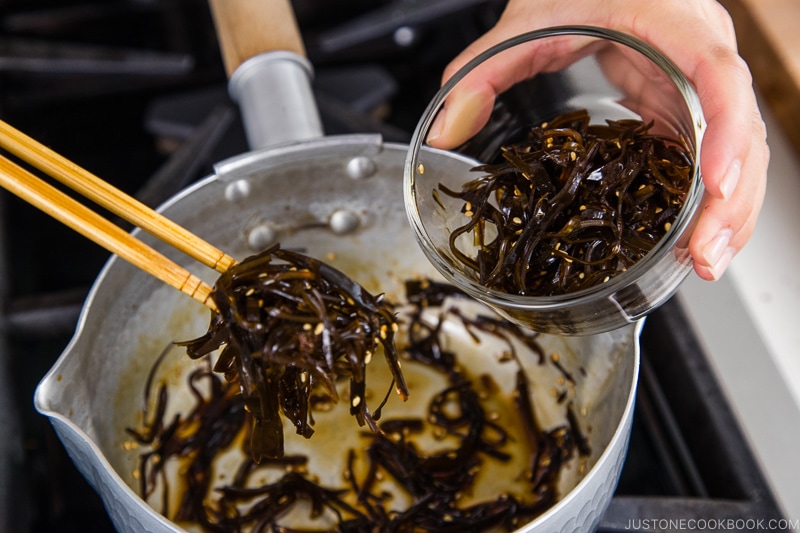
Nutrition
Did you make this recipe?
Tag @justonecookbook on Instagram so we can see your delicious creation!


